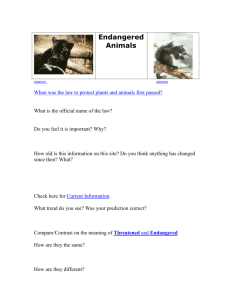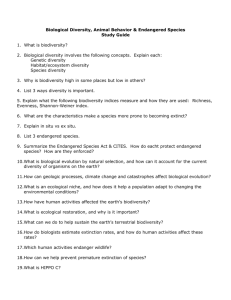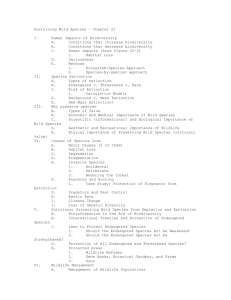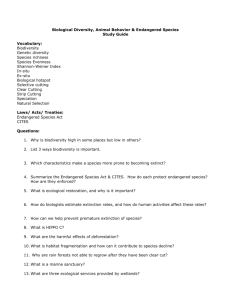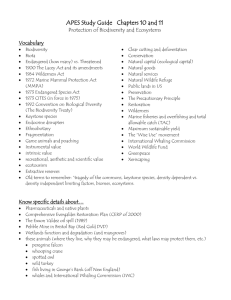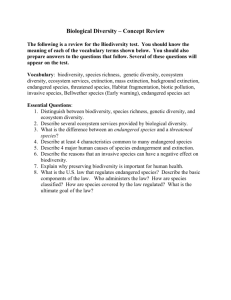1 APES Ch. 10 Notes: Wild Species and Biodiversity
advertisement
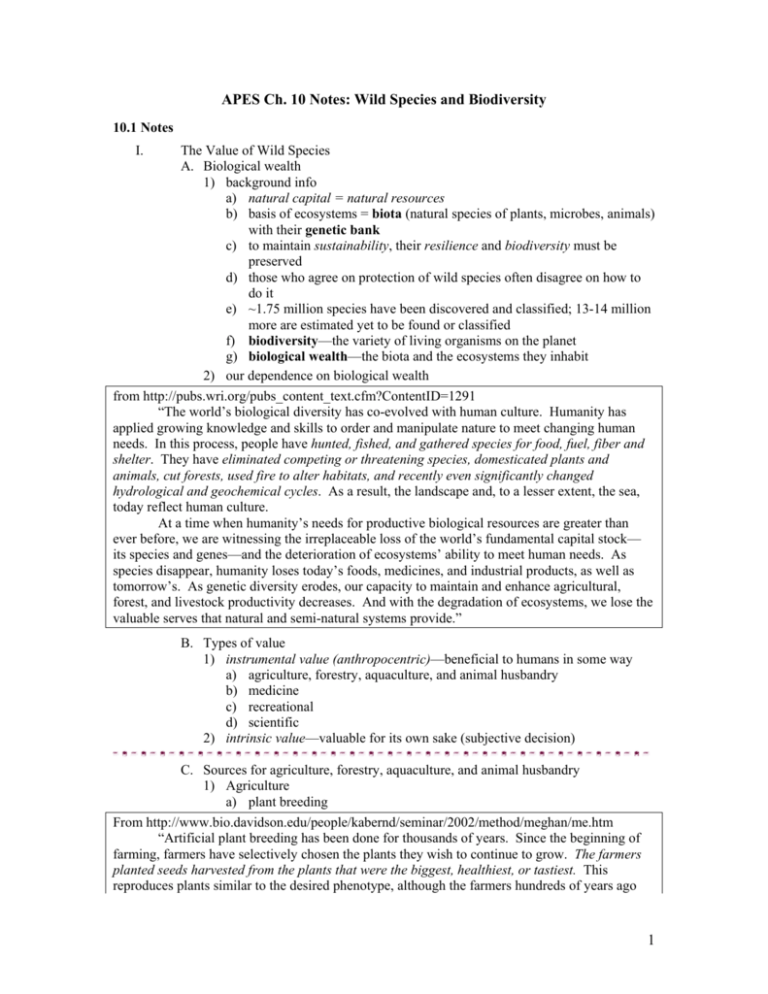
APES Ch. 10 Notes: Wild Species and Biodiversity 10.1 Notes I. The Value of Wild Species A. Biological wealth 1) background info a) natural capital = natural resources b) basis of ecosystems = biota (natural species of plants, microbes, animals) with their genetic bank c) to maintain sustainability, their resilience and biodiversity must be preserved d) those who agree on protection of wild species often disagree on how to do it e) ~1.75 million species have been discovered and classified; 13-14 million more are estimated yet to be found or classified f) biodiversity—the variety of living organisms on the planet g) biological wealth—the biota and the ecosystems they inhabit 2) our dependence on biological wealth from http://pubs.wri.org/pubs_content_text.cfm?ContentID=1291 “The world’s biological diversity has co-evolved with human culture. Humanity has applied growing knowledge and skills to order and manipulate nature to meet changing human needs. In this process, people have hunted, fished, and gathered species for food, fuel, fiber and shelter. They have eliminated competing or threatening species, domesticated plants and animals, cut forests, used fire to alter habitats, and recently even significantly changed hydrological and geochemical cycles. As a result, the landscape and, to a lesser extent, the sea, today reflect human culture. At a time when humanity’s needs for productive biological resources are greater than ever before, we are witnessing the irreplaceable loss of the world’s fundamental capital stock— its species and genes—and the deterioration of ecosystems’ ability to meet human needs. As species disappear, humanity loses today’s foods, medicines, and industrial products, as well as tomorrow’s. As genetic diversity erodes, our capacity to maintain and enhance agricultural, forest, and livestock productivity decreases. And with the degradation of ecosystems, we lose the valuable serves that natural and semi-natural systems provide.” B. Types of value 1) instrumental value (anthropocentric)—beneficial to humans in some way a) agriculture, forestry, aquaculture, and animal husbandry b) medicine c) recreational d) scientific 2) intrinsic value—valuable for its own sake (subjective decision) C. Sources for agriculture, forestry, aquaculture, and animal husbandry 1) Agriculture a) plant breeding From http://www.bio.davidson.edu/people/kabernd/seminar/2002/method/meghan/me.htm “Artificial plant breeding has been done for thousands of years. Since the beginning of farming, farmers have selectively chosen the plants they wish to continue to grow. The farmers planted seeds harvested from the plants that were the biggest, healthiest, or tastiest. This reproduces plants similar to the desired phenotype, although the farmers hundreds of years ago 1 did not know their chances of success or understand the process of passing traits through generations. Initial variation to a plant can be induced by changing conditions where the plant is grown. This will eventually force the plant to adapt to more extreme conditions. For example, continuously growing seeds from a plant in colder conditions will slowly make that plant more likely to survive in a colder climate. Though it began with haphazard planting of seeds, plant breeding has become a specific science to manipulate the characteristics of plants. Plant breeding is defined as the controlled pollination of plants.” b) International Code of Nomenclature for Cultivated Plants • http://www.ishs.org/sci/icracpco.htm • cultivar—cultivated variety 2) Forestry from http://www.biodiv.org/programmes/areas/forest/default.asp “In the last 8000 years, about 45% of the Earth’s original forest cover has disappeared, cleared mostly during the past century. According to the Food and Agriculture Organization of the United Nations (FAO), the present area of the world’s forest is 3.9 billion hectares. This area is the equivalent to North, Central and South America combined. Forest biodiversity is being lost due to the rapid deforestation, fragmentation, and degradation of all forest types. According to FAO, there has been an annual net loss of 9.4 million hectares (0.22% annually) since 1990, of which most was natural forest in the tropics. As these figures are calculated by including the rate of reforestation, the true reality in terms of loss of natural forest may be up to 14 million hectares a year, if not more. The most important factors associated with forest and biological diversity decline are human-induced causes: conversion to agricultural land, overgrazing, unmitigated shifting cultivation, unsustainable forest management, introduction of invasive alien plant and animal species, infrastructure development (road building, hydro-electrical development urban sprawl), mining and oil exploitation, forest fires caused by humans, pollution and climate change.” 3) Aquaculture issues a) Problems, from http://www.oired.vt.edu/sanremcrsp/other/AbstractDiana.htm • escaping of aquatic crops as an invasive species • the relationship between effluents, eutrophication or pollution of water bodies, and changes in the fauna of receiving waters • land use, in particular conversion of sensitive areas such as mangroves and wetlands • water use and water loss from surface water systems • overexploitation of stock over other resource uses, such as fish oil • predator control, such as the killing of birds near aquaculture facilities • genetic alteration of existing stocks from escaped hatchery products • antibiotic and hormone use, which may influence aquatics species near aquaculture facilities b) EPA’s aquaculture threat list Sedimentation Exotic Species Climate Change Human Bias Alterations to Hydrology Habitat Loss and Degradation Air Pollution Overexploitation Dredging Aquaculture Pollution 2 from http://www.biodiversity.ru/coastlearn/bio-eng/boxes/manaquacult.html: United Nations Environment Program (UNEP) recommendations to minimize the adverse impacts of aquaculture on wild stocks: • Closed culture: better containment to prevent escape of the organism • Sterilization: easily induced way of avoiding direct genetic effects • Localization: locating farms away from wild populations, and choosing locations for sea ranching that minimize straying so as to reduce gene flow to wild populations • Coastal parks: providing totally protected areas for valuable wild populations • Reduced or selective fishing: protecting native populations by reducing fishing pressure or by directing that pressure toward cultured fish • Restrictions on transport: reducing the spread of exotic genes and diseases by restricting transport or live fish and eggs. • Gene banks: counteracting extinction of local populations by the establishment of gene banks • Minimal genetic differences from native populations: reducing effects of gene flow by minimizing the genetic differences between escaping or released fish and recipient wild populations • Training of workers: basic training of aqua-culture workers (including non-specialists) to minimize the risk of accidental releases of organisms into aquatic ecosystems” 4) Animal husbandry (animal science)—the agricultural practice of breeding and raising livestock (can be cattle, hogs, sheep, horses, poultry, goats, yaks, alpacas, llamas…) From http://www.northrock.org/sustainable_stewardship.shtml …“sustainable ranching increases profits while at the same time improves the health of grassland and riparian [land adjacent to a body of water] resources. The financial benefits are achieved by decreasing operating costs, increasing production capacity and improving livestock health. Sustainable practices generally reduce expenditures for chemical inputs and farm equipment. They also increase the productivity of rangelands providing better nutrition for livestock. If ranchers do not feed their animals antibiotics or use hormones to stimulate growth, they can sell their livestock into the growing natural foods niche market which often pays premiums. Ranchers report that sustainable management increases profitability by 15 to 25 percent.” D. Sources for medicine 1) ethnobotany— the study of how people of a particular culture and region make of use of indigenous plants 2) ethnobotanists explore how plants are used for food, shelter, medicine, clothing, hunting, and religious ceremonies 3) examples from http://world.std.com/~krahe/html1.html ALOE VERA ANISE ARROWROOT BASIL CAMPHOR CELERY CHAMOMILE CHICORY CINNAMON 3 CLOVE CORIANDER DANDELION DILL EUCALYPTUS FENNEL GARLIC GINGER GINKGO GINSENG JASMINE JUNIPER LAUREL LAVENDER LEMON MARJORAM MYRTLE NETTLE OLIVE PARSLEY PATCHOULI PEPPERMINT PEPPER RADISH RHUBARB ROSE E. Recreational, aesthetic, scientific value Gathering herbs, berries, Viewing scenery mushrooms, etc. Swimming Mountain biking Boating Camping Fishing Hunting Bird watching SAGE SANDALWOOD SESAME ST. JOHN’S WORT TARRAGON TEA TREE THYME TURMERIC VALERIAN VERBENA YARROW YLANG-YLANG Backpacking Hiking Field research Ecotourism F. Value for their own sake 1) Long-established existence merits a right for continued existence. 2) Religious views supporting respect for the environment 3) No “moral justification” for species decimation 10.2 Notes II. Saving Wild Species A. U.S. Fish and Wildlife Service (FWS) 1) http://www.fws.gov/ 2) Law Digest: http://www.fws.gov/laws/laws_digest/resource_laws.htm B. North American game animals 1) common examples B = big game; U = upland; W = waterfowl Bear (B) Grouse (U) Pronghorn antelope (B) Bighorn Sheep Hare Quail (U) Buffalo Javelina/Peccary Rabbit (U) Caribou (like a pig) Raccoon Chukar (bird) Moose (M) Sandhill Crane Deer (B) Mountain goat Squirrel (U) Dove Muskrat Swan Duck (W) Partridge Turkey Elk (wapiti) (B) Pigeon Wild boar Goose (W) Pheasant (U) Woodcock(U) 2) main types of hunting: upland-game, waterfowl, big-game, and pest 3) pests: coyotes, crows, woodchucks, groundhogs Quotes from http://www.sportsmanschoice.com/A%20Note%20Worth%20Reading/hunting.htm 4) “Critics of game hunting refer to it as a blood sport that causes needless suffering and death to harmless animals in order to satisfy primitive desires in those who do not need to hunt to live. They also point out that the tons of 4 lead from shotgun cartridges and bullets deposited in the environment each year have caused a steady rise in toxic lead poisoning in animals, including endangered species who ingest it.” 5) “Proponents of game hunting point out that killing animals quickly is often more humane than letting them starve slowly in regions where the animal population may be too large to be supported by the limited food available in the habitat.” C. Suburban animal migration 1) increased roadkills of wild animals 2) increased incidence of rabies 3) attacks of cougars, alligators, bears, coyotes etc. on humans and/or small pets 4) Canada geese flocks in parks D. Animal Damage Control (“Wildlife Services”) 1) a program of the United States Department of Agriculture, Animal and Plant Health Inspection Service 2) spends millions of dollars to kill thousands of predators coyotes, wolves, bears, mountain lions, and many others as a subsidy for the livestock industry 3) animals are shot, poisoned, gassed, snared, and caught in leghold traps E. Acts protecting endangered species (from http://www.fws.gov/endangered/esasum.html) 1) Lacey Act (of 1900, recent amendments – 1981)—prohibits trade in wildlife, fish, and plants that have been illegally taken, possessed, transported or sold 2) Endangered Species Preservation Act of 1966—allowed listing of only native animal species as endangered and provided limited means for their protection 3) Endangered Species Conservation Act of 1969—provided additional protection to species in danger of worldwide extinction 4) Endangered Species Act (ESA) of 1973 (amended many times since) from http://www.epa.gov/Region5/defs/html/esa.htm “The Endangered Species Act provides a program for the conservation of threatened and endangered plants and animals and the habitats in which they are found. The U.S. Fish and Wildlife Service of the Department of the Interior maintains the list of 632 endangered species (326 are plants) and 190 threatened species (78 are plants). Species include birds, insects, fish, reptiles, mammals, crustaceans, flowers, grasses, and trees. Anyone can petition FWS to include a species on this list. The law prohibits any action, administrative or real, that results in a “taking” of a listed species, or adversely affects habitat. Likewise, import, export, interstate, and foreign commerce of listed species are all prohibited.” http://www.nmfs.noaa.gov/sfa/state_federal/SlideShows/state_directors/WilliamsESAMMPA.pdf a) more provisions • listing of endangered and threatened species • development and implementation of recovery plans • regular reviews of species’ status b) categories: extinct (EX), endangered (E) , threatened (T), delisted c) conflicting parties • “property rights advocates” are ESA critics: developers, timber industry, mining industry, etc. • “recovery advocates” support reauthorization and enforcement of ESA d) pending ESA bills and amendments: 5 http://209.85.165.104/search?q=cache:Aziv81C5YgwJ:www.nationalaglawcenter.org/assets/crs/ RL33309.pdf+reauthorization+of+esa&hl=en&ct=clnk&cd=3&gl=us&client=firefox-a F. other related legislation, etc. 1) Marine Mammal Protection Act (MMPA) of 1972 http://www.nmfs.noaa.gov/sfa/state_federal/SlideShows/state_directors/WilliamsESAMMPA.pdf a) protects all marine mammals b) prohibits, with certain exceptions, the “ take” of marine mammals in U.S. waters and by U.S. citizens on the high seas c) prohibits, with certain exceptions, the importation of marine mammals and marine mammal products into the U.S. d) NMFS (National Marine Fisheries Service) maintains marine mammals at or above optimum sustainable population levels e) regular assessment of marine mammal stocks 2) National Oceanic & Atmospheric Administration (NOAA) http://www.noaa.gov/ 3) Convention on International Trade in Endangered Species of Wild Fauna and Flora (CITES), 1973 • an international agreement to ensure that international trade in specimens of wild animals and plants does not threaten their survival G. species information, quotes from http://wdfw.wa.gov/ (species can have a different designation nationally vs. state-wide) 1) species of least concern (LC) a) the wildlife is abundant and is likely to survive in the wild b) native wildlife may be prescribed as least concern wildlife even if • the population size or distribution of the wildlife has declined • there is insufficient information about the wildlife to conclude whether the wildlife is common or abundant or likely to survive in the wild 2) species of concern “include those species listed as State Endangered, State Threatened, State Sensitive, or State Candidate, as well as species listed or proposed for listing by the U.S. Fish and Wildlife Service or the National Marine Fisheries Service.” 3) monitor species are not considered Species of Concern but are monitored for status and distribution 4) candidate species “Include fish and wildlife species that the Department will review for possible listing as State Endangered, Threatened, or Sensitive. A species will be considered for designation as a State Candidate if sufficient evidence suggests that its status may meet the listing criteria...” 5) sensitive species “Any wildlife species native (to the area) that is vulnerable or declining and is likely to become endangered or threatened throughout a significant portion of its range (within the area) without cooperative management or removal of threats.” 6) threatened species (T) have populations in a rapid decline a) definition: “Any wildlife species native (to the area) that is likely to become an endangered species within the foreseeable future throughout a significant portion of its range (within the area) without cooperative management or removal of threats.” b) examples: bald eagle, bay checkerspot butterfly 7) endangered species (EN) 6 8) 9) 10) 11) a) have populations nearing the estimated critical number b) “seriously threatened with extinction throughout all or a significant portion of its range” c) faces a very high risk of extinction in the near future. d) examples: cheetah, blue whale, snow leopard, whooping crane critically endangered species (CR) a) faces an extremely high risk of extinction in the immediate future b) examples: ivory-billed woodpecker, Arakan forest turtle, Javan rhino extinct (EX) a) the last remaining member of the species had died, or is presumed beyond reasonable doubt to have died b) examples: Dodo bird, passenger pigeon extinct in the wild (EW) a) captive individuals survive, but there is no free-living, natural population b) example: Alagoas curassow bird vulnerable (V) a) faces a high risk of extinction in the medium-term b) examples: gaur ox, lion H. controversy 1) peregrine falcon a) DDT affected egg shells, causing fewer viable offspring b) U.S. Fish and Wildlife Service and other organizations: release of captive-bred birds c) the species, once endangered, is now delisted 2) whooping crane flocks (see map on next page) a) non-migratory Florida flock b) Texas/Canada migratory flock c) Florida/Wisconsin migratory flock 3) northern spotted owl vs. Pacific Northwest timber industry, settled by the Northwest Forest Plan 4) Klamath river salmon—diverting water flow, affecting other species from 10.2, section H map from http://www.whoopingcrane.com/MIGRATION.HTM 7 10.3 Notes III. Biodiversity and Its Decline A. As stated previously, ~1.75 million species have been discovered and classified; 13-14 million more are estimated yet to be found or classified B. Decline facts from http://www.countdown2010.net/?id=41 a) “The abundance of species has declined by 40% between 1970 and 2000. b) Since 2000, 36 million hectares of primary forest have been lost each year. c) In the Caribbean region, hard coral cover has declined by 80%. d) 35% of mangroves have been lost in just 20 years. e) Global ecosystem services are estimated at $16-$64 trillion. Why care? As noted by the Millennium Ecosystem Assessment (MA) released in March 2005, human activities have taken the planet to the edge of a massive wave of species extinctions, further threatening our own well-being. For instance, current rates of loss are estimated at 100 to 1,000 times natural background levels. These findings are confirmed by the statistics from the IUCN Red List of over 15,500 threatened species, which show that 23% of mammals, 12% of birds and 31% of amphibians globally are threatened. 8 The Millennium Assessment puts a special emphasis on how ecosystem services contribute to human well-being and concludes that humanity’s future depends on healthy ecosystems...” C. reasons for the decline 1) physical alteration of habitats a) conversion to human-made uses: urbanization, deforestation, etc. b) fragmentation—natural geographic ranges are “cut up” due to construction, farming, etc. c) simplification—clearing and cleaning up land areas of natural debris; stream channelization, etc. d) intrusion—interference with species: telecommunication lighted towers attracting migrating birds, casing collisions and entanglement in wires, etc. 2) human population explosion 3) pollution a) land and water pollution: pesticides, toxic waste, oil spills, eutrophication of water, pathogens from human waste b) air pollution and related issues: NOx, SOx, acid deposition; ozone depletion, GHG (Greenhouse gases) 4) exotic (invasive alien) species a) introduction can be accidental or deliberate (ornamentation, horticulture, aquaculture) b) can take over an area, competing with native species for resources c) invasive plant examples from http://www.fws.gov/invasives/index5A.html Hoary cress (Whitetop) Cogon grass Purple loosestrife Phragmites (reed) Kudzu Salt cedar Russian knapweed Chinese tallow Brazilian pepper tree Eurasian water milfoil Perennial pepperweed Canada thistle Leafy spurge Melaleuca d) invasive animal examples from http://www.fws.gov/invasives/index5A.html Nutria (like beavers) Round goby (fish) Brown Tree Snake Mediterranean Fruit Fly (“medfly”) Alewife (fish) Gypsy moth Feral pigs Zebra mussel Japanese shore crab Ruffe (fish) Rusty crayfish Sea lamprey Mitten crab 5) overuse and overexploitation a) deforestation b) nonsustainable agricultural practices: overcultivation, etc. c) overfishing d) excessive hunting e) illegal poaching f) illegal exotic species trade 6) urbanization D. some consequences of declining biodiversity 1) simplification of the ecosystem 2) possible loss of keystone species—species which are vital to maintaining diversity of life and whose extinction would consequently lead to the extinction of other forms of life 9 3) alteration of the balance and performance of ecosystems 4) diminished resistance to invasive species 5) decreased uncategorized organisms 10.4 Notes IV. Protecting Biodiversity A. general info from http://www.countdown2010.net/?id=92 SEVEN STEPS TO SAVE BIODIVERSITY 1) “Species and ecosystems need space to develop and recover. At least 10% of all ecosystem types should be under protection to maintain nature and natural landscapes. 2) Without biodiversity there will be no agriculture. Farming practices should not jeopardize species survival: improving farmland diversity and reducing the usage of pesticides and fertilizer are key efforts to saving biodiversity. Organic agriculture practices can serve as an example in many areas. 3) 75% of all fisheries are fully exploited or over-fished. Species like cod, haddock and halibut are already threatened. If we do not move towards sustainable use, there will be no fish left for our grandchildren. 4) Roads, factories and housing destroy habitats for animals and plants. If urban and rural development continues to ignore nature, our surroundings will be dominated by concrete and pollution. 5) Climate change is considered to be the greatest challenge for humanity. With changing conditions, ecosystems and habitats will change as well. It is an obligation to fight climate change and make sure that species can migrate or adapt to new surroundings. 6) If you release a species outside its usual habitat, it might simply die. In other cases, the so-called alien invasive species have thrived and destroyed local flora and fauna. As you never know how things turn out, reducing these invasions is crucial. 7) Biodiversity is the foundation for sustainable development. Its ecosystem services provide the basis for all economic activity. Biodiversity concerns need thus be integrated into all areas of policy-making. Measures include market incentives, development assistance, biodiversity-friendly trade and international governance processes.” B. International developments 1) IUCN: International Union for Conservation of Nature and Natural Resources (World Conservation Union) a) classifies species b) publishes data in “red lists” c) more info from http://www.iucn.org/en/about/ “The World Conservation Union is the world’s largest and most important conservation network. The Union brings together 82 States, 111 government agencies, more than 800 nongovernmental organizations (NGOs), and some 10,000 scientists and experts from 181 countries in a unique worldwide partnership. 10 The Union’s mission is to influence, encourage and assist societies throughout the world to conserve the integrity and diversity of nature and to ensure that any use of natural resources is equitable and ecologically sustainable. The World Conservation Union is a multicultural, multilingual organization with 1000 staff located in 62 countries. Its headquarters are in Gland, Switzerland.” 2) Convention on International Trade in Endangered Species of Wild Fauna and Flora (CITES), 1973 • an international agreement to ensure that international trade in specimens of wild animals and plants does not threaten their survival 3) Convention on Biological Diversity (CBD) / Biodiversity Treaty a) background info from http://www.biodiv.org/convention/default.shtml “Signed by 150 government leaders at the 1992 Rio Earth Summit, the Convention on Biological Diversity is dedicated to promoting sustainable development… the Convention recognizes that biological diversity is about more than plants, animals, microorganisms and their ecosystems– it is about people and our need for food security, medicines, fresh air and water, shelter, and a clean and healthy environment in which to live.” b) Global Biodiversity Outlook 2001 link: http://www.biodiv.org/gbo1/gbo-pdf.shtml 4) Critical Ecosystem Partnership Fund http://www.cepf.net/xp/cepf/ “The Critical Ecosystem Partnership Fund is a joint initiative of Conservation International, the Global Environment Facility, the government of Japan, the MacArthur Foundation, and the World Bank. The Critical Ecosystem Partnership Fund (CEPF) enables conservation action and builds capacity for sustainability in biodiversity hotspots, the Earth’s biologically richest and most endangered regions.” C. Stewardship concerns – how we can help 1) revisit and reform policy 2) practice conservation in everyday life 3) fund more research on biodiversity • biodiversity informatics, from http://www.cs.umd.edu/hcil/biodiversity/ “We are building information retrieval and analysis interfaces for the rapidly expanding domain of biodiversity and ecological databases. Biodiversity databases contain organism-related information such as distribution, taxonomy, natural history, and conservation data. They are as complex as molecular and medical biology resources, yet serve a broad audience as do generaluse digital libraries.” 4) responsible land use/landscape planning 5) protection of certain ecosystems, wherever they are 6) enforce geographically specified nature protection areas 11

